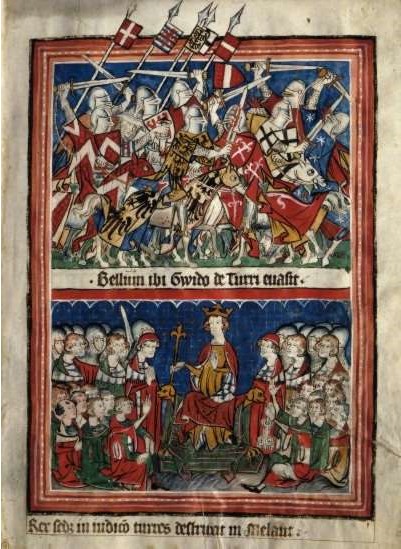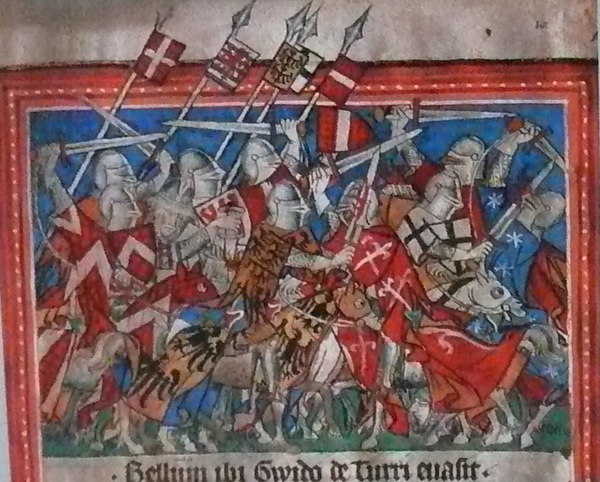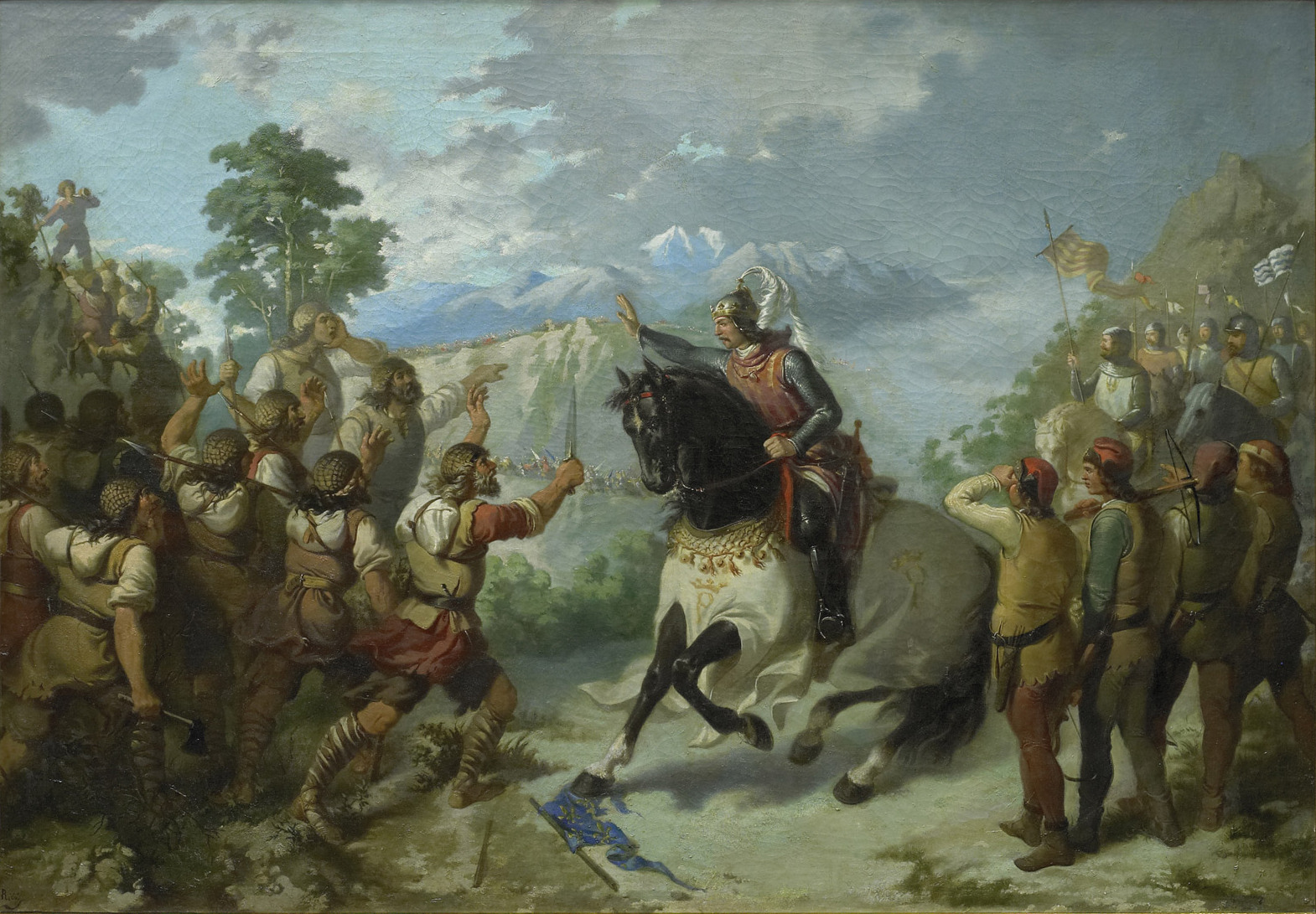|
1311
Year 1311 ( MCCCXI) was a common year starting on Friday of the Julian calendar. Events January – March * January 6 – Henry VII, the future Holy Roman Emperor, is crowned King of Italy in Milan with a mock-up of the Iron crown of Lombardy. The Tuscan Guelphs refuse to attend the ceremony and begin preparing for resistance against Henry's rule. Henry approves the despotic regimes of Matteo I Visconti in Milan and Cangrande I della Scala in Verona. The cities of Piedmont and Lombardy submit to Henry – in accordance with the proclaimed program of peace and justice. Florence and their Guelph (anti-imperialist) allies in Tuscany and Romagna move to defend themselves against Henry's accession.Jones, Michael, ''The New Cambridge Medieval History, Vol. VI: c. 1300-c. 1415'', Cambridge University Press, 2000. Page 533ff * February 12 – Milan Uprising: German forces under Baldwin of Luxembourg (brother of Henry VII) crush the Italian Guelph troops, led by Guido ... [...More Info...] [...Related Items...] OR: [Wikipedia] [Google] [Baidu] |
Duchy Of Athens
The Duchy of Athens (Greek language, Greek: Δουκᾶτον Ἀθηνῶν, ''Doukaton Athinon''; Catalan language, Catalan: ''Ducat d'Atenes'') was one of the Crusader states set up in Greece after the conquest of the Byzantine Empire during the Fourth Crusade as part of the process known as Frankokratia, encompassing the regions of Attica and Boeotia, and surviving until its conquest by the Ottoman Empire in the 15th century. History Establishment of the Duchy The first duke of Athens (as well as of Thebes (Greece), Thebes, at first) was Otto de la Roche, a minor Duchy of Burgundy, Burgundian knight of the Fourth Crusade. Although he was known as the "Duke of Athens" from the foundation of the duchy in 1205, the title did not become official until 1260. Instead, Otto proclaimed himself "Lord of Athens" (in Latin language, Latin ''Dominus Athenarum'', in French language, French ''Sire d'Athenes''). The local Greeks called the dukes "Megas Kyris" (, "Great Lord"), from which ... [...More Info...] [...Related Items...] OR: [Wikipedia] [Google] [Baidu] |
Battle Of Halmyros
The Battle of Halmyros, known by earlier scholars as the Battle of the Cephissus or Battle of Orchomenos, was fought on 15 March 1311, between the forces of the Frankish Greece, Frankish Duchy of Athens and its vassals under Walter V of Brienne, Walter of Brienne against the mercenaries of the Catalan Company, resulting in a decisive victory for the mercenaries. Engaged in conflict with their original employers, the Byzantine Empire, the Catalan Company had traversed the southern Balkans and arrived in southern Greece in 1309. The new Duke of Athens, Walter of Brienne, hired them to attack the Greek ruler of neighbouring Thessaly. Although the Catalans conquered much of the region for him, Walter refused to pay them and prepared to forcibly expel them from their gains. The two armies met at Halmyros in southern Thessaly (or at the Boeotic Cephissus, near Orchomenus (Boeotia), Orchomenos, according to an earlier interpretation). On the Athenian side, many of the most important l ... [...More Info...] [...Related Items...] OR: [Wikipedia] [Google] [Baidu] |
Henry VII, Holy Roman Emperor
Henry VII (German: ''Heinrich''; Vulgar Latin: ''Arrigo''; 1273 – 24 August 1313),Kleinhenz, pg. 494 also known as Henry of Luxembourg, was Count of Luxembourg, King of Germany ('' Rex Romanorum'') from 1308 and Holy Roman Emperor from 1312. He was the first emperor of the House of Luxembourg. During his brief career he reinvigorated the imperial cause in Italy, which was racked with the partisan struggles between the divided Guelph and Ghibelline factions, and inspired the praise of Dino Compagni and Dante Alighieri. He was the first emperor since the death of Frederick II in 1250, ending the Great Interregnum of the Holy Roman Empire; however, his premature death threatened to undo his life's work. His son, John of Bohemia, failed to be elected as his successor, and there was briefly another anti-king, Frederick the Fair, contesting the rule of Louis IV. Life Election as King of the Romans Born around 1273 in Valenciennes, he was a son of Count Henry VI of Luxembo ... [...More Info...] [...Related Items...] OR: [Wikipedia] [Google] [Baidu] |
Walter V, Count Of Brienne
Walter V of Brienne (; – 15 March 1311) was Duke of Athens from 1308 until his death. Being the only son of Hugh of Brienne and Isabella de la Roche, Walter was the heir to large estates in France, the Kingdom of Naples, and the Peloponnese. He was held in custody in the Sicilian castle of Augusta between 1287 and 1296 or 1297 to secure the payment of his father's ransom to the Aragonese admiral Roger of Lauria. When his father died fighting against Lauria in 1296, Walter inherited the County of Brienne in France, and the counties of Lecce and Conversano in southern Italy. He was released, but he was captured during a Neapolitan invasion of Sicily in 1299. His second captivity lasted until the Treaty of Caltabellotta in 1302. Walter settled in France and married Joanna of Châtillon. After his cousin Duke Guy II of Athens died childless in 1308, Walter laid claim to the Duchy of Athens. Their cousin Eschiva of Ibelin also claimed the duchy, but the High Court of Achaea ... [...More Info...] [...Related Items...] OR: [Wikipedia] [Google] [Baidu] |
Matteo I Visconti
Matteo I Visconti (1250–1322) was the second of the Milanese Visconti of Milan, Visconti family to govern Milan. Matteo was born to Teobaldo (o Tibaldo) Visconti, Teobaldo Visconti and Anastasia Pirovano. In 1287, Matteo's uncle Ottone Visconti, Roman Catholic Archdiocese of Milan, archbishop and first lord of Milan, nominated him as ''capitano del popolo'' of Milan. Following his uncle's death in 1295, he succeeded him as lord of Milan. Matteo was appointed numerous times as Imperial Vicar over the whole of Lombardy, while expanding, with the assistance of his sons, his sphere of influence to Piedmont, Emilia (region of Italy), Emilia, Bologna, and Genoa. Caught between the Papal and Imperial power struggle over northern Italy, Matteo would renounce his imperial title as "General Lord of the Milanese People". Found guilty on the charge of necromancy, excommunication, excommunicated, and facing a crusade, Matteo resigned his position and died months later. He was succeeded by ... [...More Info...] [...Related Items...] OR: [Wikipedia] [Google] [Baidu] |
Milan Uprising (1311)
An uprising of the Guelph faction in Milan led by Guido della Torre (hence also known as the Torriani faction) on 12 February 1311 was crushed by the troops of King Henry VII on the same day. Background Henry had arrived in Milan some weeks earlier, on 23 December 1310, and had been crowned King of Italy on 6 January 1311.Jones, Michael, The New Cambridge Medieval History, Vol. VI: c. 1300-c. 1415, Cambridge University Press, 2000, 533f. The Tuscan Guelphs refused to attend the ceremony, and began preparing for resistance. Henry also rehabilitated the Visconti, the ousted former rulers of Milan, who returned from exile. Guido della Torre, who had thrown the Visconti out of Milan, objected and organised a revolt against Henry. Uprising Around noon of 12 February, Duke Leopold of Austria, returning from a pleasure ride with few companions, was passing the Torriani quarter on his way back to his camp outside of Porta Comasina, northwest of the city, when he heard unusual noise of ... [...More Info...] [...Related Items...] OR: [Wikipedia] [Google] [Baidu] |
Cangrande I Della Scala
Cangrande (christened Can Francesco) della Scala (9 March 1291 – 22 July 1329) was an Italian nobleman, belonging to the della Scala family that ruled Verona from 1308 until 1387. He was indeed one of the most important characters at the time of signorie during the period where italy divided in comuni. Now perhaps best known as the leading patron of the poet Dante Alighieri and featuring prominently in Giovanni Boccaccio's almost contemporary '' Decameron'', Cangrande was in his own day chiefly acclaimed as a successful warrior and autocrat. Between becoming sole ruler of Verona in 1311 and his death in 1329 he took control of several neighbouring cities, notably Vicenza, Padua and Treviso, and came to be regarded as the leader of the Ghibelline faction in northern Italy. Early life Cangrande was born in Verona, the third son of Alberto I della Scala, ruler of Verona, by his wife Verde da Salizzole. Christened Can Francesco, perhaps partly in punning homage to his uncle ... [...More Info...] [...Related Items...] OR: [Wikipedia] [Google] [Baidu] |
Guido Della Torre
Guido della Torre (27 September 1259 – summer 1312) was a Lord of Milan between 1302 and 1312. Early life He was the son of Francesco della Torre (brother of Napoleone della Torre), Podestà of Novara (d. 1277) and his wife, Giulia, daughter of Corrado Castiglioni, Podestà di Tortona and Isola Lampugnani. Biography As part of the factional turmoil between the Guelphs and Ghibellines, the conflict of Guido’s Guelph family with the Ghibelline Visconti, led by Ottone Visconti, dominated much of his childhood. In 1277, after the Battle of Desio, in which he lost his father, he was taken prisoner with his uncle Napoleone, and imprisoned in the castle of Baradello at Como. He escaped from this castle in 1284, with the help of Loterio Rusca, the Lord of Como and William VII, Marquess of Montferrat. He fled with his uncle Raimondo della Torre, who was the Patriarch of Aquileia. In 1287 Guido became Podestà of Treviso. After his escape from the castle Baradello, Guido led th ... [...More Info...] [...Related Items...] OR: [Wikipedia] [Google] [Baidu] |
Catalan Company
The Catalan Company or the Great Catalan Company (; , , , or ) was a company of mercenaries led by Roger de Flor in the early 14th century and hired by Byzantine Emperor Andronikos II Palaiologos to combat the increasing power of the Anatolian beyliks. It was formed by '' almogavar'' veterans of the War of the Sicilian Vespers, who had remained unemployed after the signing in 1302 of the Peace of Caltabellotta between the Crown of Aragon and the French dynasty of the Angevins. Origin The military demands of the Reconquista stimulated the formation of the elite light infantry known as the '' almogavars'' on the Iberian peninsula during the 13th century. These troops were used quite effectively by the Crown of Aragon for other imperial ventures in the Mediterranean, particularly the War of the Sicilian Vespers. They were typically organised in companies (''societates'') of 20 to 50 men, following a chief of recognized military skill. The signing of the Peace of Caltabellotta i ... [...More Info...] [...Related Items...] OR: [Wikipedia] [Google] [Baidu] |
Iron Crown
The Iron Crown (in Italian, Latin, and Lombard: ''Corona Ferrea''; ) is a reliquary votive crown, traditionally considered one of the oldest royal insignia of Christendom. It was made in the Middle Ages, consisting of a circlet of gold and jewels fitted around a central silver band, which tradition held to be made of iron beaten out of a nail of the True Cross. In the later Middle Ages, the crown came to be seen as a heritage from the Kingdom of the Lombards and was used as regalia for the coronation of some Holy Roman Emperors as kings of Italy. It is kept in the Duomo of Monza. Description The Iron Crown is so called because it contains a one-centimetre-wide band within it that is said to have been beaten out of a nail used at the crucifixion of Jesus. The outer circlet of the crown is made of six segments of beaten gold, partly enamelled, joined together by hinges. It is set with 22 gemstones that stand out in relief, in the form of crosses and flowers. Its small size a ... [...More Info...] [...Related Items...] OR: [Wikipedia] [Google] [Baidu] |
Milan
Milan ( , , ; ) is a city in northern Italy, regional capital of Lombardy, the largest city in Italy by urban area and the List of cities in Italy, second-most-populous city proper in Italy after Rome. The city proper has a population of nearly 1.4 million, while its Metropolitan City of Milan, metropolitan city has 3.2 million residents. Within Europe, Milan is the fourth-most-populous List of urban areas in the European Union, urban area of the EU with 6.17 million inhabitants. According to national sources, the population within the wider Milan metropolitan area (also known as Greater Milan) is estimated between 7.5 million and 8.2 million, making it by far the List of metropolitan areas of Italy, largest metropolitan area in Italy and List of metropolitan areas in Europe, one of the largest in the EU.* * * * Milan is the economic capital of Italy, one of the economic capitals of Europe and a global centre for business, fashion and finance. Milan is reco ... [...More Info...] [...Related Items...] OR: [Wikipedia] [Google] [Baidu] |
March 15
Events Pre-1600 * 474 BC – Roman consul Aulus Manlius Vulso celebrates an ovation for concluding the war against Veii and securing a forty years truce. * 44 BC – The assassination of Julius Caesar, the dictator of the Roman Republic, by a group of senators takes place on the Ides of March. * 493 – Odoacer, the first barbarian King of Italy after the fall of the Western Roman Empire, is slain by Theoderic the Great, king of the Ostrogoths, while the two kings were feasting together. * 856 – Michael III, emperor of the Byzantine Empire, overthrows the regency of his mother, empress Theodora (wife of Theophilos) with support of the Byzantine nobility. * 897 – Al-Hadi ila'l-Haqq Yahya enters Sa'dah and founds the Zaydi Imamate of Yemen. * 933 – After a ten-year truce, German King Henry the Fowler defeats a Hungarian army at the Battle of Riade near the Unstrut river. * 1311 – Battle of Halmyros: The Catalan Company d ... [...More Info...] [...Related Items...] OR: [Wikipedia] [Google] [Baidu] |




